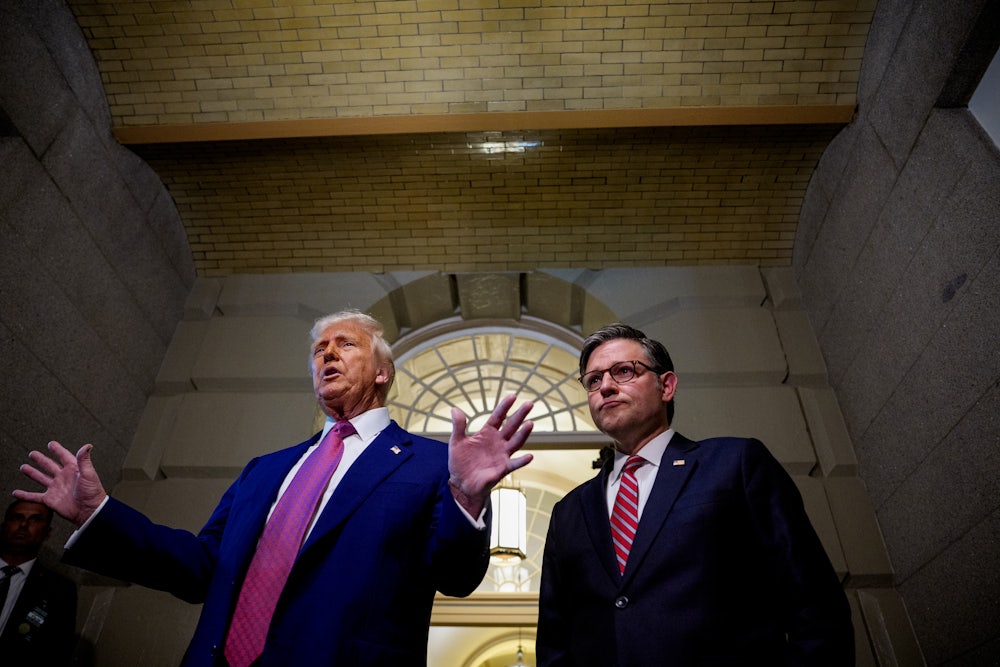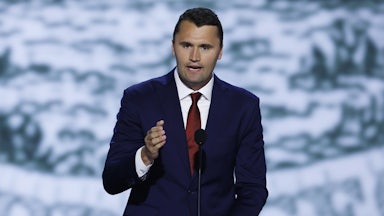Republicans are so gravely concerned about the national debt, right? After all, they’re the party of prudence and fiscal responsibility. They’re the grown-ups in the room, the ones who tap the brakes while those crazy, irresponsible Democrats keep pumping the accelerator, spending like drunken sailors on shore leave in Macau.
So, a question for you. Of all the non-wartime presidents going back to 1900, who are the top five in terms of adding to the national debt?
First, I stipulate “non-wartime presidents” because financing a war, by definition, means adding massively to the debt. During wartime, everybody understands this. In this sense, Woodrow Wilson and Franklin Roosevelt are the debt kings. They each increased the national debt by a staggering percentage—nearly 800 percent in both cases. But the former helped win World War I, aiding the cause of democracy and making the United States a global power for the first time, and the latter defeated fascism. Especially in the second case, it was worth every penny.
After them, who’s next, do you suppose? Maybe LBJ, with all that Great Society money sluicing through those shambolic, on-the-take community organizations? Jimmy Carter, the first modern president to leave us with what seemed at the time like a gaping deficit?
The answer is: no and no. The top five modern presidents in terms of percentage added to the national debt are, in order: Ronald Reagan; George W. Bush; Barack Obama; George H.W. Bush; and Donald Trump, term one. That’s right. Four of the top five were Republicans. And though I know some would not agree, I’d put an asterisk next to Obama’s name. He took office during the heat of the biggest economic crisis since the Great Depression, which happened under George W. Bush’s watch, and with the private-sector economy in free fall and credit drying up, he had little choice at the time but to pump money into the economy. (And one of the biggest knocks on Barack is that he didn’t go bigger. He took a lot of stick for the slowness of the recovery for the sake of not adding more to the debt.)
But generally speaking, it’s been Republican presidents who’ve piled up the debt. And it’s not very close. Reagan’s percentage was 160.8; Dubya’s was 72.6. Obama’s was 64.4, Bush Sr.’s 42.3, and Trump’s 39.2 (those last two, remember, in just four years, not eight). So, golly—how can it be that the party of fiscal prudence is the party that runs up the debt?
It’s not a coincidence, folks. The debt is the amount of money the government has to borrow to cover its expenses. Said expenses are incurred, of course, when the government spends more than it takes in. Conservatives like to blame excessive spending, and it does no one a disservice to say that at times, they’re onto something.
But here’s an interesting point for us to chew on. In the 34 years after 1946 (that is, after World War II), the national debt went from 106 percent of gross domestic product to just 25 percent. The government was spending like crazy in those years: constructing a vast national security state, building interstate highways, creating Medicare and Medicaid, expanding the welfare state in myriad other ways. And yet, the debt remained under control.
What changed after 1980? Massive tax cutting is what changed. In the 1970s, the right cooked up the lie that cutting taxes would actually increase revenues. Since this is what rich people in the donor class were aching to hear, it was really, really popular.
But guess what? It didn’t pan out that way. The 1981 tax cuts cost the Treasury $445 billion over the next four years (see this 2006 study; go down to page 16, line nine, and add up the first four numbers). The tax cuts blew a huge hole in the deficit, and that’s when the government started borrowing to beat the band. The same thing happened under Dubya.
And now here we sit, a generation later, with the GOP House having passed their big, beautiful bill that will add a whopping $3.8 trillion to the current national debt of $36 trillion. Astonishingly, House Speaker Mike Johnson claimed on Meet the Press Sunday that the bill is “not going to add to the debt.” This is an unusual lie even by his standards. The number is real, and $3.8 trillion is the low estimate.
How can the party of fiscal responsibility do such a thing, you may ask?
We answer this question by asking another one. What are the potential impacts of excessive debt? Here’s a list from the fiscally hawkish Peterson Institute of Top 10 reasons why the national debt matters. Some are more persuasive than others, but for our purposes, reasons three and six in particular caught my eye:
“Higher interest costs could crowd out important public investments that can fuel economic growth—priority areas such as education, research & development, and infrastructure.”
“The unsustainable fiscal path threatens the safety net and the most vulnerable in American society. If the government does not have sufficient resources, essential programs like Medicaid and Social Security could be put in jeopardy.”
You following me? Republicans want these crises. Crowd out public investments? Put essential safety net programs at risk? You and I might call these potential calamities. Republicans call them an essential part of the platform.
So a large debt, and big yearly budget deficits, are for Republicans a feature, not a bug. They’re the best arguments Republicans have for attacking Democrats over excessive spending. Which, by the way, is kind of funny in and of itself, because far and away the biggest spender on non-defense discretionary items of the last 20 years? Donald Trump (see Figure 4).
That was pandemic-related, so it was understandable. But the point remains that for the better part now of 50 years, Republicans talk one game and play another.
Democrats are not of course blameless here. First of all, too many of them, in the 1980s and the early 2000s (though not in 2017), went along with these huge tax cuts. Second, one lesson they need to ponder from the Biden years is where to draw the line on spending. The Biden spending bills didn’t cause inflation, but they did contribute to it. As Democrats draw up their plans to reconnect with working-class voters, they need to keep in mind that sometimes there are other ways to respond to social ills than by creating a big new government program.
But at least they’re trying to address social ills—all while being the more fiscally responsible party, and the party that, as I’ve written several times, has been far better for the economy in recent history. Republicans want social ills—they keep people angry at government. And once the nation is reeling, Republicans are less interested in solving problems than using them as a political bludgeon against Democrats.
Because who cares? Like Joni Ernst says, we’re all gonna die anyway.










